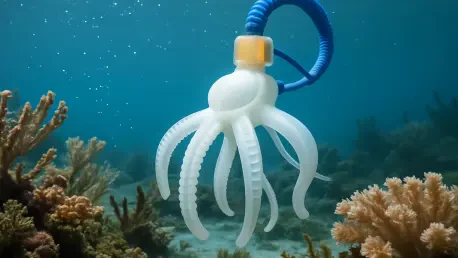The evolution of underwater exploration has taken a significant leap forward with the advent of RoboNautilus, an innovative robotic system that employs the quiet and efficient propulsion techniques of ancient cephalopods. These marine creatures, such as squids and nautili, have long mastered the art of pulsed jet propulsion—a method allowing them to navigate the ocean depths by repeatedly expanding and contracting their mantle cavities to move water through controlled jets. Inspired by this natural design, the RoboNautilus represents modern advancements in soft robotics, bridging the gap between biological marvels and technological innovation. Spearheading this breakthrough, Mihai Duduta and his team from the University of Connecticut have now redefined underwater movement with this bio-inspired invention, showcasing the prowess of nature’s blueprint when adapted into modern engineering solutions. Their research, published in npj Robotics, underscores the transformative potential of integrating ancient natural designs into contemporary robotic technology.
Mimicking Ancient Cephalopods
The core concept behind RoboNautilus lies in the successful replication of cephalopod dynamics to create a robotic system that is both efficient and minimally disruptive to marine environments. Cephalopods have evolved over millions of years to adopt a streamlined method of propulsion, a feature crucial to their survival and maneuverability in ocean habitats. By mimicking these processes, RoboNautilus achieves low-noise operation—a critical advantage in conducting sensitive marine research without disturbing the natural equilibrium. Duduta and his graduate students faced a significant challenge in translating the fluid mechanics of natural cephalopods into a practical robotic form. Central to overcoming this hurdle was the development of soft actuators that accurately replicate the soft-bodied nature of cephalopods, an endeavor complicated by the traditional reliance on rigid motors or bulky hydraulic systems. This innovative approach illustrates a paradigm shift in robotics, breaking away from constraints of mechanical rigidity and harnessing the gentler, more adaptive features of smart materials for environmental integration.
Dielectric Elastomer Actuators
Central to RoboNautilus’s success are dielectric elastomer actuators (DEAs), which redefine the propulsion dynamics in soft robotics by acting as deformable solid-state actuators. These actuators respond to electrical stimuli by altering their shape, providing a smooth and silent propulsion system that eliminates the need for rigid components. DEAs offer high efficiency and compactness, making them ideal for underwater use where space conservation and unobtrusive movement are paramount. Their versatility provides RoboNautilus with continuous swimming capabilities, onboard sensing, and environmental monitoring tools—advantages traditional robotic designs largely lack. This technological leap circumvents the limitations posed by previous designs, paving the way for soft-bodied robots that can independently operate under various aquatic conditions. The incorporation of such cutting-edge technology highlights a broader shift toward environmentally-conscious engineering, where silent and adaptive robotics take precedence in disciplines ranging from oceanography to biology, enabling comprehensive data collection without ecological disturbance.
Biomimicry and Soft Robotics
A distinct feature of RoboNautilus is the nuanced application of biomimicry, where innovative design solutions stem from understanding and adopting organic principles observed in nature. The essence of biomimicry lies in the application of natural mechanisms—like cephalopod propulsion—to develop technologies that merge seamlessly with their operational environments. RoboNautilus incorporates 3D printed elements reflecting the structure of Nautilus belauensis, providing historical depth alongside functional design enhancements. The robot’s internal chambers accommodate essential electronics and buoyancy systems, facilitating complex movement patterns that echo those of living cephalopods. Such adaptations ensure passive self-righting and sophisticated maneuverability, echoing nature’s ingenuity while fostering technological sophistication. These principles of biomimicry not only inform RoboNautilus’s design but also illustrate a broader trend within the field of robotics—a collective shift toward systems that prioritize environmental compatibility, offering innovative pathways for sustainable exploration.
Environmental Integration and Exploration
RoboNautilus underscores the importance of quiet and efficient operations within sensitive marine ecosystems, where traditional rigid robots often fall short due to their disruptive presence. The robot’s capacity for non-invasive data collection positions it as a valuable tool for environmental observation, equipped with onboard cameras and sensors that monitor temperature, salinity, and other relevant metrics. This capability allows for comprehensive analysis of marine conditions without perturbing the residents of the underwater habitat. Such functional integrity is crucial in preserving marine life, enabling researchers to gather critical data while respecting natural biodiversity. The overarching trend within the field is a shift toward environmentally-integrative robotics, where design aligns harmoniously with the ecosystems they aim to explore. RoboNautilus epitomizes this consensus by combining silent propulsion with advanced data acquisition—a synthesis empowering researchers to explore aquatic environments while honoring the intricate balance of nature.
Future Enhancements and Education
The development of RoboNautilus reflects ongoing efforts within the robotics community to pioneer new frontiers in exploration with minimal ecological impact. Future plans envisioned by Duduta and his team include thrust vectoring, autonomous navigation, and enhanced sensing capabilities—qualities aimed at forging a new class of underwater explorers. These advancements seek to elevate the potential for cutting-edge research, facilitating deeper insights into marine ecosystems. Furthermore, Duduta’s dedication to educational outreach is evidenced by planned activities involving high school students in Barrington, Rhode Island, challenging them to design and assess their own Nautilus-inspired machines. Such initiatives demonstrate a commitment to bridging the gap between ancient biological principles and modern technological aspirations, empowering the next generation of innovators. By engaging with aspiring engineers, the RoboNautilus project not only builds future technologies but also instills a sense of scientific curiosity and continuity, laying a foundation for sustained exploration and discovery.
Bridging Ancient and Modern Exploration
The field of underwater exploration has advanced significantly with the development of RoboNautilus, a groundbreaking robotic system that mimics the quiet efficiency of ancient cephalopods. Marine life forms such as squids and nautili excel in pulsed jet propulsion, a technique that allows them to glide through ocean depths. By expanding and contracting their mantle cavities, these creatures can move via controlled water jets. Inspired by this natural mechanism, RoboNautilus stands as a testament to modern progress in soft robotics, merging the wonders of biology with technological innovation. Leading this initiative, Mihai Duduta and the University of Connecticut team have transformed underwater movement by integrating this bio-inspired concept. This invention illustrates the remarkable potential of using nature’s designs in contemporary engineering. Their work, published in npj Robotics, highlights the transformative power of adopting ancient natural principles into today’s robotic technologies, showcasing a harmonious blend of biology and engineering.









